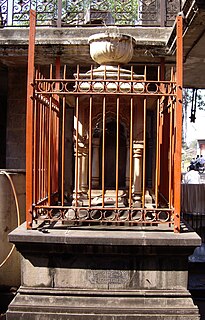 W
WThe Maratha Empire or the Maratha Confederacy was a power that dominated a large portion of the Indian subcontinent in the 18th century. The empire formally existed from 1674 with the coronation of Shivaji as the Chhatrapati and ended in 1818 with the defeat of Peshwa Bajirao II at the hands of the British East India Company. The Marathas are credited to a large extent for ending Mughal rule over most of the Indian subcontinent.
 W
WNayakas of Chitradurga ruled parts of eastern Karnataka during the post-Vijayanagara period. During the rule of Hoysala Empire and Vijayanagara Empire, they served as a feudatory chiefdom. Later after the fall of the Vijayanagara empire, they ruled at times as an independent Chiefdom and at other times as a vassal of the Mysore Kingdom, Mughal Empire and Maratha Empire. Finally their territories merged into the province of Mysore under the British.
 W
WThe Bhagwa Dhwaj also called as "Kesariyā Patākā" is a saffron color flag that served as the flag of the Marathas, "it is swallow-tailed and of a deep saffron color emblematic of the followers of Mahādeva."
 W
WThe Bhimthadi or Deccani horse is an almost extinct breed of Indian horses. It was developed in Pune district in 17th and 18th centuries during the Maratha rule by crossing Arabian and Turkic breeds with local ponies.
 W
WThe Cis-Sutlej states were a group of small states in Punjab region in the 19th century, lying between the Sutlej River on the north, the Himalayas on the east, the Yamuna River and Delhi District on the south, and Sirsa District on the west. These states were under the suzerainty of the Scindhia dynasty of the Maratha Empire. Small Punjabi kingdoms of the Cis-Sutlej states paid tributes to the Marathas, until the Second Anglo-Maratha War of 1803–1805, after which the Marathas lost this territory to the British.
 W
WThe Gaekwads of Baroda are Hindu Marathas who trace their origins to Dawadi village near Poona to a Maratha clan by the name of Matre, which means Mantri meaning Minister. A dynasty belonging to this clan ruled the princely state of Baroda in western India from the early 18th century until 1947. The ruling prince was known as the Maharaja Gaekwad of Baroda. With the city of Baroda (Vadodara) as its capital, during the British Raj its relations with the British were managed by the Baroda Residency. It was one of the largest and wealthiest princely states existing alongside British India, with wealth coming from the lucrative cotton business as well as rice, wheat and sugar production.
 W
WGharge-Deshmukh (Desai) was a Maratha dynasty and one of the oldest existing Maratha Sur-Deshmukhs of Nimsod in Satara District. The family is Agnivanshi Kshatriya, one of the most ancient in [India]
 W
WThe Great Maratha is an Indian historical drama television series directed by Sanjay Khan and produced by Numero Uno International Limited. The drama aired on DD National. The series is based on the life of Mahadaji Shinde. The show comprised 47 episodes. The music was composed by Mohammed Zahur Khayyam.
 W
WThe Holkar dynasty was a Maratha clan of kshatriya Dhangar origin in India. The Holkars were generals under Peshwa Baji Rao I, and later became Maharajas of Indore in Central India as an independent member of the Maratha Empire until 1818. Later, their kingdom became a princely state under the protectorate of British India.
 W
WJhansi was an independent princely state ruled by the Maratha Newalkar dynasty under suzerainty of British India from 1804 till 1853, when the British authorities took over the State under the terms of the Doctrine of Lapse. The fortified town of Jhansi served as its capital.
 W
WKolhapur State or Kolhapur Kingdom (1710–1949) was a Maratha princely State of British India, under the Deccan Division of the Bombay Presidency, and later the Deccan States Agency. It was considered the most important of the Maratha principalities with the others being Baroda State, Gwalior State and Indore State. Its rulers, of the Bhonsle dynasty, were entitled to a 19-gun salute – thus Kolhapur was also known as a 19-gun state. The state flag was a swallow-tailed saffron pennant.
 W
WMaratha Army refers to the land-based armed forces of the Maratha Empire, which existed from the late 17th to the early 19th centuries in India. The formation, rise, and decline of the armies of the Maratha Empire can be broadly divided into two eras
 W
WThis is a partial list of Maratha dynasties and Maratha princely states.
 W
WThe Maratha rulers, belonging to the Bhonsale dynasty, from the early 17th century to the early 18th century, built and ruled the Maratha Empire on the Indian subcontinent, mainly corresponding to the modern countries of Bangladesh, India and Pakistan. Their power rapidly dwindled during the 19th century and the last of the emperors was deposed in 1818, with the establishment of the British Raj. Starting in 1720s, the Peshwa were instrumental in expanding the Maratha Empire to cover large areas of the Indian subcontinent. At their empire's greatest extent in the late 17th and early 18th centuries, they controlled much of the Indian subcontinent, extending from Bengal in the east to Attock and Sindh in the west, Kashmir in the north to the Kaveri basin in the south. Peshwas served as subordinates to the Chhatrapati, but later, they became the leaders of the Marathas, and the Chatrapati was reduced to a nominal ruler.
 W
WThe Maratha Navy refers to the naval wing of the armed forces of the Maratha Empire, which existed from around mid-17th century to mid-18th century in India.
 W
WThe Kingdom of Nagpur was a kingdom in east-central India founded by the Gond rulers of Deogarh in the early 18th century. It came under the rule of the Marathas of the Bhonsale dynasty in the mid-18th century and became part of the Maratha Empire. The city of Nagpur was the capital of the state.
 W
WNangli Poona is a small village on main G.T. - Karnal Road in North West Delhi. Near Jain mandir.
 W
WThe Peshwa was the appointed Prime Minister of the Maratha Empire of the Indian subcontinent. Originally, the Peshwas served as subordinates to the Chhatrapati ; later, under the Bhat family, they became the de facto leaders of the Maratha Confederacy with the Chhatrapati becoming a nominal ruler, a situation roughly analogous to that of Mayor of the Palace of France, Shogunate of Japan and the Rana family of Prime Ministers of Nepal, Sarvadhikari of Kingdom of Mysore. During the last years of the Maratha Empire, the Peshwas themselves were reduced to titular leaders, and remained under the authority of the Maratha nobles and the British East India Company.
 W
WThe Ponda Fort is located in Ponda, in the state of Goa on the west coast of India.
 W
WPrataprao Gujar born in Bhosare village near Khatav which is located in Satara district, was Senapati of King Shivaji's army. After his death, his daughter was married with the second son of Shivaji named Rajaram, who was later to be the Empress of the Maratha Empire, Maharani Jankibai.
 W
WSajra and Gojra forts are hill forts built on top of Naammam Malai hill to the east of Vellore City in the state of Tamil Nadu, India. Sajra and Gojra literally means "smart" and "cute" respectively.
 W
WSatara state was a short-lived Princely state created by the British in 1818 after the Third Anglo-Maratha War and annexed by them in 1849 using the Doctrine of lapse. The state was ruled by descendants of Chhatrapati Shivaji, the founder of the Maratha Empire. The first Raja of the state was Pratap Singh who was freed by the British after they defeated Peshwa Bajirao II in 1818. Pratap Singh was deposed in 1838. His brother, Shahaji succeeded him but died without a natural heir in 1848. At that time, the East India Company government refused to accept Shahaji's adopted son as his successor and absorbed the territory into the growing British dominion.
 W
WShinde Chhatri, located in Wanwadi, a well known place in Pune, India, is a memorial dedicated to the 18th century military leader Mahadji Shinde who served as the commander-in-chief of the Maratha army under the Peshwas from 1760 to 1780. It is one of the most significant landmarks in the city and is reminiscent of the Maratha rule. It is a hall that marks the spot of Mahadji Shinde's cremation on 12 February 1794.
 W
WShivaji Bhonsale I was an Indian warrior-king and a member of the Bhonsle Maratha clan. Shivaji carved out an enclave from the declining Adilshahi sultanate of Bijapur that formed the genesis of the Maratha Empire. In 1674, he was formally crowned as the chhatrapati (emperor) of his realm at Raigad.
 W
WThe Thanjavur Maratha kingdom of bhonsle dynasty was a principality of Tamil Nadu between the 17th and 19th centuries. Their native language was Thanjavur Marathi. Venkoji was the founder of the dynasty.
 W
WWaghya was a mixed-breed pet dog of Maratha king Shivaji Maharaj, known as the epitome of loyalty and eternal devotion. After Shivaji's death, the Waghya mourned and jumped into his master's funeral pyre and immolated himself.